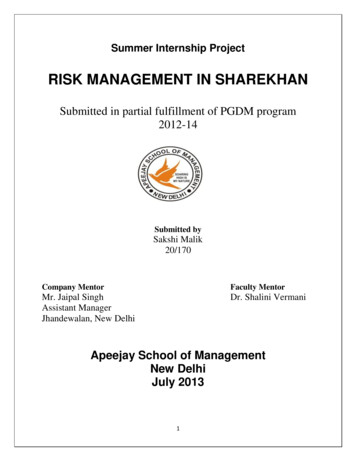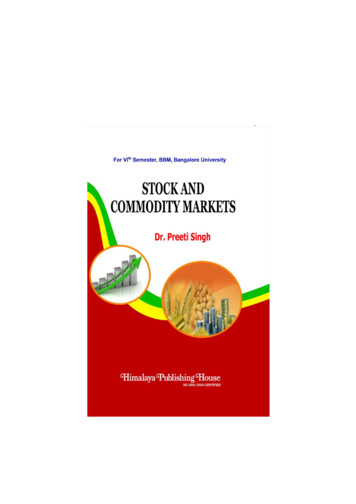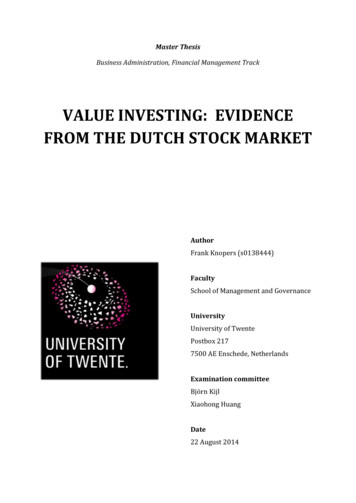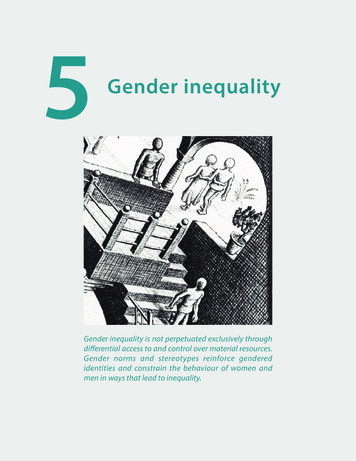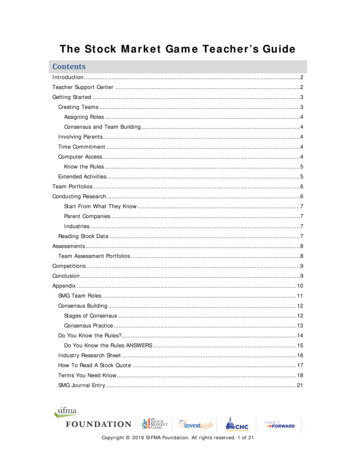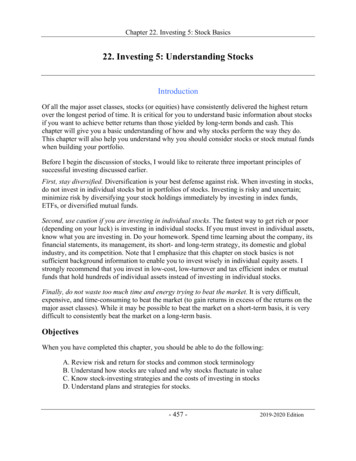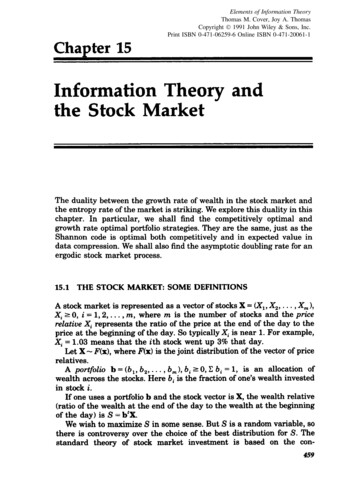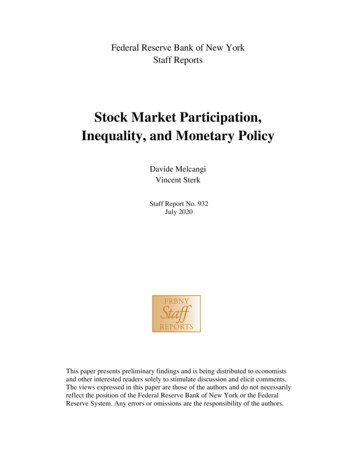
Transcription
Federal Reserve Bank of New YorkStaff ReportsStock Market Participation,Inequality, and Monetary PolicyDavide MelcangiVincent SterkStaff Report No. 932July 2020This paper presents preliminary findings and is being distributed to economistsand other interested readers solely to stimulate discussion and elicit comments.The views expressed in this paper are those of the authors and do not necessarilyreflect the position of the Federal Reserve Bank of New York or the FederalReserve System. Any errors or omissions are the responsibility of the authors.
Stock Market Participation, Inequality, and Monetary PolicyDavide Melcangi and Vincent SterkFederal Reserve Bank of New York Staff Reports, no. 932July 2020JEL classification: E21, E30, E50, E58AbstractWhat role does stock investment play in the transmission of monetary policy to the realeconomy? We study this question using a New Keynesian model with heterogeneous households.Following a monetary tightening, stock market participants rebalance their investments awayfrom stocks, in line with empirical evidence on mutual fund flows. This response depressesaggregate investment and hence aggregate output and income, which feeds back into an evenlarger decline in stock investment. The strength of this channel is, however, highly sensitive tohousehold heterogeneity. Therefore, we design the model to account endogenously for theobserved population share of stockholders, their income characteristics, and their saving behavior.We find that, quantitatively, the stock investment channel of monetary policy dominates theconsumption channels often emphasized in the literature, and also that it has become morepowerful since the 1980s, as stock market participation increased.Key words: monetary policy, stock investment, heterogeneityMelcangi: Federal Reserve Bank of New York (email: davide.melcangi@ny.frb.org). Sterk:University College London (email: v.sterk@ucl.ac.uk). The authors thank René Chalom andBrendan Moore for excellent research assistance. For helpful comments, they also thank SimonGilchrist, David Lucca, and Andrea Tambalotti, as well as various seminar and conferenceparticipants. The views expressed in this paper are those of the authors and do not necessarilyrepresent the position of the Federal Reserve Bank of New York or the Federal Reserve System.To view the authors’ disclosure statements, visithttps://www.newyorkfed.org/research/staff reports/sr932.html.
1IntroductionMonetary policy is widely believed to have a profound impact on the stock market, assuggested by the vast number of stock market analyst reports written on decisions of theFederal Open Market Committee. But what is the role of stock investors in the transmissionof monetary policy to the real economy? Textbook models of monetary policy and the macroeconomy do not assign a central role to households’ stock investments, but rather focus onhow changes in interest rates affect their consumption decisions.However, a long-standing narrative, put forward by Mundell (1963) and Tobin (1965),does suggest that at least some of the real effects of monetary policy operate via the stockmarket. These authors argued that an increase in interest rates raises the opportunity costof investments into non-interest-bearing assets. According to this logic, a higher interestrate would induce households to rebalance their wealth away from the stock market andtowards for instance saving accounts, thereby squeezing the equity funds available for capitalinvestment. Indeed, this rebalancing channel is present in virtually any model with interestbearing assets and capital investment, be it with or without household heterogeneity. Itsquantitative importance, however, remains elusive.In this paper, we argue that in order to assess the stock investment channel, it is critical toconsider heterogeneity among households regarding their participation in the stock marketand the amount of stock investment. Accordingly, we develop a New Keynesian modelwith household heterogeneity which can account for the cross-sectional relation betweenincome, saving and stock investment. A key feature of the model is the emergence of agroup of high-income households who save a large fraction of their incomes, and do soprimarily by adding to their stock portfolios. These households turn out to be critical tothe transmission of monetary policy via aggregate investment, both through “direct” effectsand through “indirect” equilibrium effects.1We find that, due to both effects, the overall stock investment channel is quantitativelyvery powerful. Moreover, the strength of the channel depends on the income distribution,as those at the top are much more likely to become stock investors. Related, we find thatover the last few decades the stock investment channel has strengthened considerably, as1The model also captures the direct and indirect channels of the transmission via consumption, as studiedin the literature. As explained by Kaplan, Moll and Violante (2017), the consumption channels work viadifferent types of households (unconstrained and liquidity-constrained households, respectively) and work inopposite directions, offsetting each other partially. By contrast, the direct and indirect effects of the stockinvestment channel that we highlight both work via the same category of households (stock investors) andpush in the same direction, reinforcing each other. As a result, this channel becomes highly sensitive to thepopulation share of stock investors. We will expand extensively on this point, starting in Section 2 withtwo simplified models.1
incomes became less equal and stock market participation increased.Before presenting the model, we provide aggregate time-series evidence which sheds lighton the potential importance of the stock investments for the pass-through of monetary policy.This evidence suggests that much of the decline in aggregate output following a monetarytightening is driven by investment rather than consumption. Related to this finding, wealso show that households reduce their net investments into equity-focused mutual fundsfollowing a monetary tightening. Finally, we show that the net investment inflows intoequity-based funds predict changes in aggregate investment into physical capital. All threepatterns are consistent with an important role for stock investments, although the preciseimportance of this channel vis-à-vis other channels can only be teased out cleanly within amodel, as they operate simultaneously.To discipline the extent of household heterogeneity in the model, we then discuss threekey cross-sectional facts. First of all, most households do not participate in the stock market.Therefore, the stock investment channel operates only via a minority of the population,although over time the participation rate has increased. Second, stock market participantsare not representative of the population. Indeed, they tend to be located at the upperechelons of the income distribution, see Porterba and Samwick (1995). We document therelation between income and stock market participation in the Survey of Consumer Finances.Third, high-income households save a relatively large fraction of their incomes, as there isa strong negative relation between income and expenditure rates, see also Dynan, Skinnerand Zeldes (2004); Straub (2017). We use data from the Consumer Expenditure Survey, todiscipline this relation in the model.We design the model to account for these facts. The model incorporates heterogeneityin permanent income, as well as idiosyncratic unemployment risk. Households can save intofully liquid, interest-bearing assets as well as into stock market funds, which are subject toa linear withdrawal tax, and are therefore relatively illiquid.2 To account for the positiverelation between income, stock market participation and saving rates, we introduce an“infrequent” consumption good, which households can enjoy only during specific periodsand which enters the utility function as a luxury good vis-à-vis regular consumption. Withsuch consumption goods we have in mind large, but relatively rare expenditures which aretypically the preserve of the rich, for example exclusive medical or old-age care, tuition forelite education, starting capital for a private business, or large donations.The infrequent good creates an additional saving motive, which is particularly relevant2In the U.S., households face a capital gains tax when selling stocks, which is particularly high when theassets are held for less than a year. Moreover, many U.S. households save in stocks via retirement accounts(IRA or 401(k)), which come with hefty early withdrawal penalties.2
to high-income households, given its luxury nature. Hence, the model predicts that highincome households have relatively high saving rates. Moreover, given that infrequent goodsare consumed only rarely, households tend to save for such goods using relatively illiquidassets which offer higher returns, i.e. stocks. Due to this feature, the model is also able togenerate a high degree of wealth inequality, and in particular a fat-tailed wealth distribution,as observed in the data.At any point in time, the population of households in the model can be categorized intothree groups who display distinctly different saving behavior. First, there are householdswho save, but only into liquid, interest-bearing assets. They do so for precautionary reasons,as households face unemployment risk. We label these households “emergency savers” andthey react to changes in the interest rate via intertemporal substitution of consumption, theconventional channel in the New Keynesian model. A second group of households has hit aborrowing constraint, due to becoming unemployed. These “hand-to-mouth” households donot respond directly to changes in interest rates, but react heavily to changes in income.The third group of households saves not only in bonds but also into stocks and we labelthem “stock investors”. They have high incomes and a high propensity to save into stocks.The stock investors’ trade-offs regarding the amount of stock purchases are characterizedby an Euler equation. This is in line with empirical evidence in Vissing-Jorgensen (2002)who shows that a frictionless Euler equation for stocks fits the micro data well, once theestimation sample is restricted to include only those households who participate in themarket.The behavior of the stock investors turns out to be pivotal for the transmission ofmonetary policy to the macro economy. Because they have the option to rebalance theamount of saving going into stocks versus liquid assets, their consumption is relativelyunresponsive to changes in interest rates. For the same reason, their investment into stockstends to react strongly when interest rates change. Moreover, stock market participantstend to invest marginal income flows into their stock portfolios, which creates the feedbackfrom household income to investment mentioned above.After calibrating the model to the US economy, we simulate the macroeconomic effectsof a monetary policy shock and find that capital investment accounts for much of the declinein aggregate output, in line with the empirical evidence. We then ask to what extent thesemacro responses are driven by the portfolio decisions of stock investors. To this end, weconduct two exercises. First, we decompose the response of aggregate investment and findthat rebalancing behavior accounts for a substantial part of its decline. The remaining partis mostly due to the equilibrium decline in aggregate income, which further reduces stockinvestments.3
Second, we consider a counterfactual version of the baseline model in which we shut downvariations in stock investment, while keeping the steady-state aggregates and distributionsunaltered. This implies that monetary policy transmits only through consumption. We findthat in the counterfactual, not only the decline in aggregate output is much smaller thanin the baseline model, but also consumption falls less persistently. Therefore, the stockinvestment channel not only matters for aggregate output directly via investment, but alsoless directly via consumption.3In the final part of the paper, we study how the transmission of monetary policy via stockinvestments interacts with inequality. In the model, inequality in wealth and consumptionincreases following a monetary tightening, and we show that this increase is driven by theportfolio decisions of stock investors. Vice versa, the presence of inequality matters forthe impact of monetary policy on macroeconomic aggregates, since distributional factorsdetermine the rate of stock market participation and the amount of stock investments.Since inequality has been trending upwards during the last few decades, the modelimplies that the macroeconomic effects of monetary policy have changed. To study theextent of this change, we compare a version of the model calibrated to the 1980s to aversion calibrated to 2000s.4 The model endogenously predicts an increase in stock marketparticipation, as incomes in the upper half of the income distribution are lifted. We findthat since the 1980s the effects of monetary policy – in particular on investment – havestrengthened considerably with the rise in inequality and stock market participation.We build on a literature which developed New Keynesian models with household heterogeneity and liquidity frictions, which emphasizes households who make a corner decisionfor liquid assets (i.e. the borrowing-constrained), see Auclert (2019); Debortoli and Galí(2017); Gornemann, Kuester and Nakajima (2016); Hagedorn, Luo, Manovskii and Mitman(2019); Kaplan, Moll and Violante (2017); Luetticke (2020); McKay, Nakamura and Steinsson (2016); McKay and Reis (2016); Ravn and Sterk (2020); Auclert, Rognlie and Straub(2020), and many others. We highlight the importance of incomplete insurance markets andhousehold heterogeneity in stock investments. Our analysis thereby complements a literature which considers the propagation of monetary policy in models with heterogeneity andfinancial frictions on the firm side, as in e.g. Bernanke, Gertler and Gilchrist (1999) andOttonello and Winberry (2018). Finally, the presence of the infrequent good relates to stud3For robustness, we consider various extensions of the model, including one in which firms face financialfrictions and household savings can reach firms via both debt and equity markets. We find that results areeither not affected at all or somewhat dampened, see Section 4.1 and Appendix 3 for details.4Holm (2020) studies the effects of an increase in household income risk on the strength of monetarytransmission. In our model experiments, we keep income risk constant, but consider shifts in the distributionof permanent income.4
ies which consider savings motives that are not traditionally found in incomplete-marketsmodels, see for instance Ameriks, Briggs, Caplin, Shapiro and Tonetti (2020), Campbelland Hercowitz (2019), and Straub (2017).2Insights from two simple modelsA key point of this paper is that the stock investment channel is highly sensitive to householdheterogeneity. This point can be understood by contrasting two highly stylized heterogeneousagents models, one with a standard consumption channel and another one with the stockinvestment channel instead. Let Y C I, i.e. aggregate income is the sum of consumptionand investment expenditures.In model 1, we focus on monetary transmission via consumption and therefore fix investment (dI 0). Thus, model 1 abstracts from the stock investment channel. A fractionhtm [0, 1] of the population are “hand-to-mouth”, i.e. their consumption is unaffected byinterest rates, but responds one-for-one to changes in income. Consumption of the remaininghouseholds responds to interest rates according to their Elasticity of Intertemporal Substi 0, but does not react to changes in income.5,6 Other than this, thetution, EIS C/C R/Rtwo types are identical. Aggregation gives: dC (1 htm) · CR · EIS · dR htm · dY . Here,the first term captures the “direct effect” of a change in interest rates, whereas the secondterm captures the consumption response to a change in income. Solving the model gives the1 htmtotal response of aggregate consumption to the interest rate: dC/C 1 htmEIS EIS,dR/Rwhere we used that dC dY .In model 2 we instead focus on investment and assume that households keep consumptionfixed (so that dC 0). Thus, this model abstracts from the consumption channels ofmonetary policy. A fraction si [0, 1] of the population consists of stock market investors.dI/I 0 and theirWe denote their interest elasticity of stock investment by IEI dR/Rmarginal propensity to invest in stocks by M P I 0. Aggregation gives dI si · RI · IEI ·dR si · M P I · dY . The first term again captures the direct effect, which operates viarebalancing of investments between stocks and interest-bearing assets. Solving the modeldI/Igives dR/R 1 MsiP I·si IEI, using that dI dY .Figure 1 illustrates the transmission in the two models. The left panel shows that inmodel 1, a higher share of hand-to-mouth weakens the direct effects of an interest ratechange on aggregate consumption, but strengthens the indirect effects, as emphasized by5We consider a static model and hence the expression for the EIS omits future consumption. One canthink of the model experiment as a purely transitory monetary shock, leaving future consumption unaffected.6That is, their Marginal Propensity to Consume (MPC) equals zero. In models with permanent-incomeconsumers, the MPC typically equals the interest rate, and is therefore close to zero at short horizons.5
Figure 1: Effect of an interest rate change on aggregate consumption and investment.Consumption ResponseInvestment ect0.60.810share of hand-to-mouth0.20.40.60.81share of stock market participantsNote: Left panel: elasticity of aggregate consumption w.r.t. the interest rate in simple model 1. Right panel: elasticity ofaggregate investment w.r.t. the interest rate in simple model 2.Kaplan et al. (2017). However, on net the two forces cancel out exactly here and the overallresponse is unaffected by the heterogeneity.By contrast, the investment response (model 2, right panel) is unambiguously increasingin the share of stock market participants. This happens because an increase in the participation rate strengthens both the direct effects and the indirect income effects, the latter ina highly convex way due to equilibrium feedbacks. Following an increase in interest rates,stock investors rebalance their portfolio away from stocks. This reduces aggregate investment, and therefore aggregate output and income. The reduction in income in turn feedsback into even lower stock investment, and so on. The strength of both the initial effect andthe equilibrium feedback is proportional to the stock market participation rate. Thus, whenconsidering the transmission of monetary policy through investment, heterogeneity mattersnot only for the mix of channels, but also for the aggregate effects.Finally, note that in the amplification mechanism in this model, marginal propensitiesto consume play no role. In the quantitative model, there will be an additional amplification mechanism related to the interaction between investment and liquidity-constrainedhouseholds with high marginal propensities to consume, as analyzed recently by Auclert etal. (2020).77See also Bilbiie, Kanzig and Surico (2020) for related analysis on this additional mechanism, emphasizingthe role of capital income inequality.6
3Empirical evidenceBefore introducing the full model, we present empirical evidence on the effects of monetarypolicy on households’ stock investments, based on a time-series approach. We also discussempirical patterns regarding heterogeneity in stock market participation and investmentsacross households, which will be used to impose discipline on the full model.3.13.1.1Time-series evidenceResponses to a monetary policy shockTo obtain a better sense of the potential relevance of the stock investment channel, weconsider the empirical effects of a monetary policy shock. A key variable of interest isthe amount which households invest in stocks. We obtain data on this from the InvestmentCompany Institute (ICI), which collects data on mutual fund flows covering the vast majorityof regulated mutual funds in the United States. We consider the net inflow into equityfocused mutual funds, which is defined as the amount of new investment into the fundminus withdrawals.8 Importantly, this variable is not directly affected by changes in stockvaluations. Therefore, the variable gives direct insight into the amounts of income whichhouseholds set aside for stock investment. We scale the variable by the lagged value of totalnet assets in the funds, but we obtained similar results when results are not scaled.The empirical methodology follows Miranda-Agrippino and Ricco (2018), who use highfrequency changes in interest rates around FOMC decisions to identify exogenous monetarypolicy shocks, but correct for information effects using the Fed’s Greenbook forecasts. Responses are then estimated using a Bayesian local projection, based on monthly data overthe period 1985-2014. Figure 2 shows the responses of a number of macro and financialvariables to a 100bp increase in the Federal Funds Rate. On the macro side, the responsesare in line with the conventional wisdom in the literature. A monetary tightening leads toa substantial fall in real activity (industrial production) and in prices, and an increase inunemployment. Non-durable consumption also declines, but much less than the decline inindustrial production, which falls by about three to five times as much. This indicates thata large part of the decline in output following a monetary tightening can be attributed toinvestment into physical capital.98Reported as net new cash flow, it is equal to new purchases of mutual fund shares, plus net exchanges,minus redemptions.9The responses plotted do not include aggregate investment into physical capital since this variable is notavailable at a monthly frequency. However, it is a common finding in the literature that investment respondsmuch more strongly to monetary policy shocks than consumption (see for instance Christiano, Eichenbaumand Evans (2005)). We have verified this result based on an alternative specification on quarterly data.7
Figure 2: Empirical responses to a monetary tightening.Mutual fund inflow ratioS&P 500Effective Unemployment Rate0.40.3-0.1-0.2-20CPI All0.2%%6NondurableConsumptionIndustrial Production-1.5-3.5-0.2%-1.5Business (months)Source: Investment Company Institute, FRED.Note: Horizontal axis is monthly horizon in all panels. “Mutual fund inflow ratio” is the net inflow into equity funds definedas in the text, rescaled by lagged net total assets. All US Equity funds, according to ICI definition. Aggregate time seriesdefined with the following FRED codes: S&P 500 (S&P 500), Business Loans (BUSLOANS), Industrial Production (INDPRO),Real Nondurable consumption (DNDGRA3M086SBEA), CPI all items (CPIAUCSL), Unemployment rate (UNRATE). Sampleperiod is 1985:1-2014:12, and a pre-sample 1969:1-1984:12 is used to inform the priors. 12 lags as in Miranda-Agrippino andRicco (2018). The shock is taken from Miranda-Agrippino and Ricco (2018) and normalized to induce a 100 basis point increasein the effective Fed Funds rate. Shaded areas are 90% confidence bands.Particularly informative for the mechanism outlined in this paper, we show in red howa monetary policy contraction implies a substantial decline in the net inflow of investmentsinto the stock market funds. Thus, a monetary policy shock induces households to eitherpull out more funds from their stock portfolio and/or invest less into stock market funds.Quantitatively, the response is substantial: the reduction in the net inflow corresponds tomore than 1 percent of the total value of the funds. The tightening also leads to a fallin stock prices, as measured by the S&P 500 index, which is consistent with evidence inBernanke and Kuttner (2005).These empirical results are consistent with the idea that tight monetary policy depressescapital investment, as investment into stocks decline. However, one may wonder if therebalancing behavior towards interest-bearing assets, e.g. bank accounts, might lead to an8
Figure 3: Equity fund inflows and physical capital investment: dynamic correlations.0.6investment(t), mutual funds inflow ratio (t k)0.5correlation0.40.30.20.10-4-3-2-101234k (quarters)Note: Sample: 1984Q1:2014Q4. “Mutual funds inflow ratio” is the net inflow into equity funds defined as in the text, rescaledby lagged net total assets. All US Equity funds, according to ICI definition. Both the inflow and total net assets are aggregatedfrom monthly to quarterly frequency, and then we consider the ratio of net inflow to total net assets lagged by one quarter.increase in bank lending to firms. To assess this possibility we also consider the responseof bank loans to businesses, obtained from the Flow of Funds. We find that, following amonetary tightening, business lending actually declines. Thus the decline in equity availableto firms does not appear to be offset by an increase in bank lending.103.1.2Mutual fund flows and capital investmentAn important element of the Mundell-Tobin narrative is that a decline in stock marketinvestments by households ultimately reduces investments into physical capital. While theresponses to a monetary policy shock discussed above are consistent with such a link, wenow assess whether the connection holds more generally. To this end, Figure 3 plots thedynamic correlation between mutual fund inflows from the ICI, and real aggregate capitalinvestment from the National Income and Product Accounts.Figure 3 shows that the two variables correlate positively. Considering the dynamicpatterns, we observe that mutual fund flows lead aggregate capital investment by one quarter. This is consistent with the idea that a reduction in stock investments by householdsdepresses the amount of funds that are available for capital investment. The actual declinein physical investment might occur with some lag due to planning constraints or adjustmentcosts.10We also find that nonfinancial corporate debt (i.e.: debt securities and loans) falls.9
3.2Cross-sectional evidenceWhile the time series evidence above suggests that stock investments matter for the transmission of monetary policy, their quantitative importance can only be precisely isolated ina model. The simple model described in the previous section suggests that the stock investment channel may be highly sensitive to household heterogeneity regarding the extensiveand intensive margin of stock investments.In this subsection, we document a number of cross-sectional patterns which will imposeempirical discipline on our full-blown heterogeneous-agents model, presented in Section 4.3.2.1Income and stock market participationWe first investigate how stock market participation varies with income in the U.S., andhow this relationship has changed over time. To this end, we use data from the Surveyof Consumer Finances (SCF). Our measure of stock market participation includes directownership of stocks, but also indirect ownership via mutual funds. We focus on the years1988 and 2000, since during this period there was an important increase in stock marketparticipation. Moreover, the cyclical state of the US economy was similar in those twoyears.11 Across the population, the stock market participation rate increased from 25 percentin 1988 to 44 percent in 2000. Whilst there was a strong increase, it continued to be thecase that the majority of the population does not participate in the stock market.The left panel of Figure 4 plots income versus stock market participation rate, by laborincome decile (indicated by markers). Labor income is measured as wage income aftertax and unemployment transfers and the horizontal axis indicates the share of aggregateincome of the various deciles. The figure shows that stock market participation rate isstrongly increasing in income, except for the low end of the income distribution.12 In 1988,the participation rate across income deciles ranged from less than 10 percent to more than60%. By 2000, this relationship had shifted upwards and the participation rate ranged fromslightly below 20 percent to almost 85 percent.Closer inspection of Figure 4 reveals that the increase in participation was disproportionately driven by households with incomes above the median, in particular by those in the60-80 percentiles of income. This suggests that the increase in stock market participationmight have been related to the increase in income inequality that was observed in the US11Also, 1988 is the first year in the SCF that allows us to construct a measure of stock market participation that includes IRAs and 401k’s mostly invested in stocks, as outlined in Appendix 1. Stock marketparticipation plateaued after 2000.12The data for lowest two deciles overlap precisely since the households at bottom 20 percent all havezero labor income. This group includes retirees, which explains the drop in participation.10
Figure 4: Stock market participation and expenditure rates by income decile.0.93198820002.50.70.6Expenditure ratesShare of stock market 050.10.150.20.250.30.3500.4Share of aggregate income00.050.10.150.20.250.30.35Share of aggregate incomeNote left panel: Source: Survey of Consumer Finances. We define as stock market participant a household that reports inthe SCF at le
The stock investors’ trade-offs regarding the amount of stock purchases are characterized by an Euler equation. This is in line with empirical evidence inVissing-Jorgensen(2002) who shows that a frictionless Euler equat

